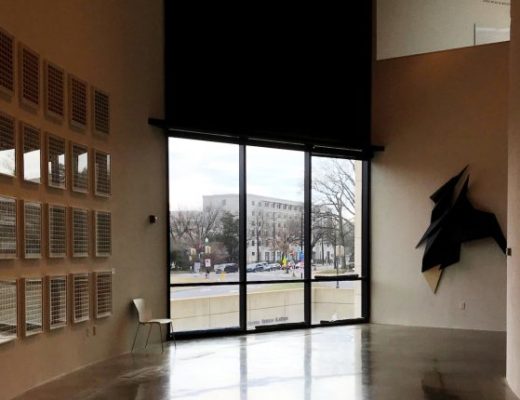by Athena Naylor
This article was first published in The DC Line and can be read on that site here.
Each winter, DC offers a variety of spectacles that coincide with the Season of Light, from ZooLights at the National Zoo to the public light art display GLOW in Georgetown. This year, the Susan Calloway Fine Arts gallery contributes its own luminous display to the season with its show Drawn by Light, a retrospective of neon sculpture artist and DC resident Craig Kraft on display through Friday.
You may have seen Kraft’s work without realizing it. His studio in Anacostia is responsible for the neon sculpture outside the Shaw (Watha T. Daniel) Neighborhood Library, along with an array of other commissioned light sculptures brightening public spots in Silver Spring, Rockville and Arlington. At the Susan Calloway gallery in Georgetown, the Drawn by Light exhibit acquaints viewers with Kraft’s smaller, more personal projects, offering a concise yet eclectic selection of works from his 35-year career.
Kraft is a master and devoted advocate of neon light as an artistic medium, which he appreciates for its versatility in color and form. He has taught neon light sculpture at the Smithsonian Institution Studio Arts Program since 1992.
On his website, Kraft describes the nature of light as something “tangible but intangible” that “begs questions of perception and importance.”
This artistic philosophy can be seen in various works in the gallery show, including “Ground Zero III.” In this piece from 2013, Kraft uses neon tubing to highlight a drawn lizard in a photograph of dense graffiti inside the Ground Zero Blues Club in Clarksdale, Mississippi. The neon tubing interacts with and transforms the photograph, altering our perception of the graffiti and its symbols. Kraft adds his own mark to an image already filled with layered inscriptions that span the history of the Ground Zero establishment.
The concept of mark-making has been a significant focus of Kraft’s practice in recent years, and has motivated him to travel to Africa, Southeast Asia and Europe to view some of the oldest known human rock and cave drawings. These trips inspired several works in Drawn by Light, including “Castillo Hands Flickering Light.” This piece re-creates the prehistoric hand stencils found in the Cave of El Castillo in Spain through acrylic paint on paper, which Kraft backlights with a pulsing glow that mimics the flickering light on a cave wall.
Kraft’s travels also inspired one of the more striking pieces in the exhibit, “The Damaged Spirit of the African Elephant.” Made of parallel layers of bright blue aluminum and neon tubing bent into three dimensions, the piece depicts the head of an elephant with glowing red marks dissecting its trunks, referencing the ongoing poaching of this endangered species.
Regarding this piece and a related larger elephant sculpture in his studio, Kraft writes that light can represent the simultaneously material and immaterial of an animal spirit, suggesting “an inner spiritual world much more complex than its outer appearance.”
Pieces like this do lose some impact, however, because they are isolated from their companion pieces from Kraft’s full series. In particular, “Castillo Hands” would benefit from the contextualizing company of the other light sculptures in Kraft’s “Cave Drawings” series.
In Drawn to Light, the works that really shine (both literally and figuratively) are those that explicitly celebrate neon light, without using the medium to illuminate or represent another visual or physical component. “Pulsing Neon,” for example, comprises an abstract tangle of different-colored neon tubes crammed into a shadow box. The neon jumble emits a gently pulsing light that makes the piece feel alive, like a breathing, organic circuit.
“Unintentional Drawing III,” from 2009, presents the viewer with an abstract drawing composed of swirling tubes of blue neon light. The title is engaging because it seems contradictory to the artwork. Nothing appears unintentional in this piece, the only one in the exhibit that allows viewers to peer behind the back panel and see the electrical wiring — a glimpse of the immense forethought that must go into each neon work.
Both “Pulsing Neon” and “Unintentional Drawing III” highlight Kraft’s interest in recognizing the overlooked, reconstructing new pieces out of random discarded materials in his studio. The neon tubing in the latter piece is a translation of a mindless doodle Kraft then reimagined into a massive light sculpture, suggesting the meaningful significance in unconscious actions and creations.
The pieces reviewed here are a small selection of the works displayed in Drawn by Light. To present 35 years of work in a small, upstairs gallery is a challenge, especially for a retrospective show, but the exhibit offers a succinct introduction to Kraft’s artistry beyond his more monumental public sculptures. The gallery show is a welcome stop for anyone who appreciates the manifold possibilities of light during a dark winter.
Drawn by Light opened on Nov. 30 and will be on view through Dec. 28 at the Susan Calloway Fine Arts gallery at 1643 Wisconsin Ave. NW. To learn more about Craig Kraft and his studio, you can visit his website and read about his travels through his contributions to the magazine Timeless Travels.





No Comments